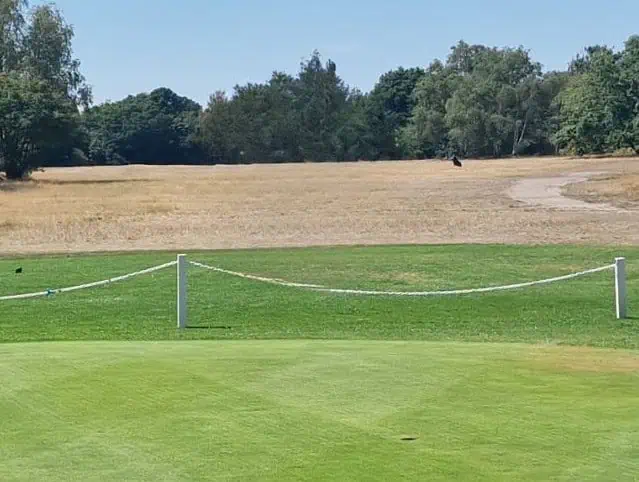It’s hot. Very hot. And it’s dry. While the women’s final is underway at Wimbledon Stadium and spectators are collapsing in the 30+ degree heat, three men are standing on the first tee of Wimbledon Common Golf Club. A few square meters of green, behind it brown grass as far as the eye can see. England’s golf courses are facing a water crisis. According to the British Meteorological Service, rainfall in London, for example, was 40 percent below the average for the previous ten years in May, 19 percent in June and 68 percent in July.
“Many clubs are struggling with costs because they use main water,” says renowned golf consultant Eddie Bullock, summarizing the situation. “Only a comparatively small proportion of clubs have prepared for emergency situations when it comes to water.”
In fact, the English golf industry is in a particularly precarious situation compared to other internationally relevant golfing nations. According to estimates by the BIGGA and the national water suppliers, between 50 and 74 percent of golf courses use main water that is not publicly but privately owned in England. The first water suppliers, Yorkshire Water and South East Water, have already issued usage restrictions for households in the past two weeks, which include bans on watering gardens or washing cars, for example. “For the future, it is unclear to what extent the water suppliers will issue volume guidelines or stop supplying golf courses,” summarizes Bullock.
“We’ve already used two thirds of our water by the end of June, so from now on it’s really a gamble,” explains the manager of one of London’s best-known private clubs, who prefers not to be named when it comes to water. “We just hope it will last until September.” You hear this and very similar sentences more often these days when you talk to the managers of English golf clubs. The situation is critical and the next few months are uncertain.
Massive rise in water costs
Regardless of the amount available, costs have also long been an issue. “The cost of water is a much higher item in our budget this year than usual,” summarizes Robert Brewer, General Manager of the Royal Wimbledon Golf Club. While annual water bills of 800,000 dollars and more for the irrigation of 18 holes are not uncommon on courses in California, water consumption bills have long played a subordinate role in England. This summer, however, numerous golf courses will exceed the 100,000 pound mark. Water has therefore become a significant cost factor.
Situation was foreseeable
This situation comes as no surprise. Back in 2020, the BIGGA issued the following warning after the drought at the time: “These extreme climatic conditions will quickly become the norm and pose a fundamental threat to the sustainability of golf courses.” England Golf hosted a Water Summit in 2023 to raise awareness of the threat. The consultancy Gather Golf organized a water conference in Cambridge in 2024. The Greener Golf Network, an association of 25 golf courses in Leicestershire, organized its own water conference for these clubs in 2024. “Awareness is growing slowly,” summarizes Bob Roberts from the Greener Golf Network. “Very few clubs have the management and resources to act long term.”
Subscribe to our newsletter!
News & trends about sustainability in golf
If you are looking for positive examples, you will find them. A storage pond with a capacity of 110,000 cubic meters was built at Woburn Golf Club. In Walton Heath there is a reservoir with a capacity of 26,000 cubic meters. Water from a well is used. Anyone walking across the 36-hole top course in south-west London will constantly encounter greenkeepers who use sensors to measure the moisture level of the greens. Manual watering has long since replaced the complete irrigation of the greens. The annual consumption of the courses with 36 holes, is significantly less than 30,000 cubic meters this year. Most top golf courses can only dream of such figures.
However, the British golf industry – as in almost all other countries – lacks a real overview of the situation. There is no reliable database on consumption, water type or even costs, which is why the BiGGA is currently approaching the clubs again with a survey in order to be able to speak to the public on the subject of water.
Tap water also for tennis and soccer
The golf industry is not alone in this: in the vast majority of cases, main water is also used to water the tennis courts in English tennis and soccer. How much water is used to water the courts at Wimbledon during the two weeks of the tournament is not publicly known. For the 18 clay courts at Roland Garros, Canard Enchaine calculated a requirement of 2000 to 4000 liters per day during the French Open 2023, i.e. a maximum of 56 cubic meters over two weeks of the tournament. The irrigation area of a complete tennis court is approximately just under 700 m³ and is therefore slightly larger than that of an average green.
These are all arithmetic games that do not get past the fundamental challenges facing golf associations, managers and boards:
- Data collection to obtain a fact-based assessment of water consumption on golf courses.
- Raising awareness of the issue of climate change and water.
- The creation of strategies for facilities and clubs to achieve a high level of water resilience.
- Linking golf courses with funding programs that promote investment in sustainable water management.
- Communicating all these issues to the golfer, who must realize that water is a limited and increasingly expensive resource.
Will this put golfers off their hobby? Hardly, apparently. On this Thursday at any rate, as we walk past tee one and the putting green at Wimbledon Common, the tee times are well filled. Golf is an all-weather sport – that applies not only to rain, but also to dry weather.








